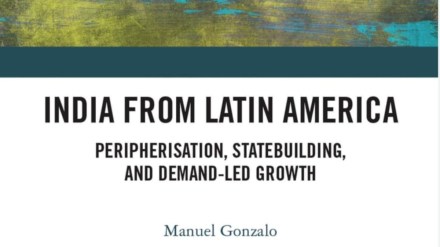An Argentinean scholar Manuel Gonzalo has authored a book which studies the economic history of India and goes on to trace its development trajectory from a Latin American perspective.
In the book titled “India from Latin America: Peripherisation, Statebuilding, and Demand Led growth’’ the author goes on to share his thoughts about the development path of India comprehensively with detailed data and comprehensive research.
“It has three main parts. In the first part, I discuss how the Indian subcontinent was transformed from a regional productive center to a global periphery by the British. This process is discussed as a process of peripherisation, stating some comparisons with the Latin American global insertion during the colonial period,” says Manuel Gonzalo.
“In the second part, the Indian State-building, specifically the configuration of the Indian National system of Innovation is presented and discussed. Different geopolitical, productive and technological issues are interrelated to understand the Indian capabilities-building, its achievements and challenges.
Finally, in the third part of the book, the Indian growth acceleration process is presented and discussed as well as the relevance of the Indian Ocean and the Indo-Pacific international relations.”
More about the author
He is Adjunct Professor at the Degree on Development Economics of the UNQ (Universidad Nacional de Quilmes), Associate Professor at the school of economics of UNDEC (Universidad Nacional de Chilecito), and Co-Coordinator at the South Asia working group of CARI (Consejo Argentino para las Relaciones Internacionales). And he assesses Latin American governments, firms, think tanks, and international organizations in building their relationship with India, South Asia, and the Global South.
In a short interaction Manuel Gonzalo tells Huma Siddiqui about the book, India’s energy security and more.
Following are excerpts
What is the concept behind this book?
The book, in fact, is a sub-product of my PhD thesis. So… the story started in 2014 in Rio de Janeiro, Brazil, with a research project on BRICS based on Redesist (Research Network on Local Productive and Innovative Systems) at the Universidade Federal de Rio de Janeiro. We started studying the BRICS National Systems of Innovation. Since then, during my PhD courses, different professors stimulate me in order to advance with the study of the economic development of India, given that there are not so many contributions and specialists on this area in Latin America. Then I expanded the research scope to a long term understanding of the Indian path of development from a Latin American perspective, mainly a structuralism perspective.
In 2016, I stayed as a visiting researcher in India for around four months based at the Center for Development Studies (CDS) in Kerala. During this period I interacted and discussed with different Indian scholars and policymakers, visiting the Indian Institute of Science (IIS), Bangalore, the Indira Gandhi Institute of Development Research (IGIDR) and the Indian Institute of Technology (IIT) Delhi among others.
Who should read this book?
The book will be of interest to scholars and researchers of heterodox economics, Indian economy, comparative economics, political economy, economic history, development studies, Latin American studies, and South Asian studies. This book is available on Amazon.
India is focusing on its energy security… so… how can India and the region work together?
In the book, I analyze a little bit the Indian energy investments and the public-private complementation. And the public and private investments trends in the context of the Indian energy transition in a paper published in the BRICS Policy Center of the Pontifical Catholic University of Rio de Janeiro. As you mentioned, energy security is perhaps the main issue for the Indian foreign policy. In fact, if you look at the relation between India and Latin America, energy agreements and investments are the ones that have advanced more… You can see this in Brazil and in Colombia.
In the case of Argentina, in addition to the more long-term state-led collaborations and exchanges around nuclear energy, there are several opportunities for private complementation in GNL and around VacaMuerta (Dead Cow) in terms of shale oil. Also in Lithium. Recently three Indian geologists came to Argentina to study the potentialities. However, by now, most of the investments in this matter are Chinese and from the Global North firms.With all respect, India should be more assertive on this issue. In the particular case of Argentina, financing and demand are crucial for us, given that we are experiencing a foreign sector restriction: we need both exports and FDI. At the same time, there is a huge agenda in terms of R&D cooperation, but this has to be financed and sustained.
American sanctions stop India from doing oil trade with Iran and Venezuela. What are your views?
Not an easy question… It is true that India stopped buying Iranian oil after the US sanctions on Iran in 2019… But, if we look at what happened during the Ukraine conflict, India has increased its imports of Russian oil, despite the pressure of the US. So… India has played her game. Then, India is pushing a foreign policy that promotes energy diplomacy, with her main State-owned enterprises and National business groups internationalizing in order to buy new petroleum and energy reserves. I understand that energy efforts are being done, but still more than 1/3 of Indian imports are related to energy.
In this changing world… How does India secure its energy requirements? Then energy diplomacy and the internationalization of the Indian energy SOEs and national business groups, that are being done, could be reinforced with much more money. Finally, I understand that India is involved in different nuclear energy projects with Russia, isn’t it? This could also be expanded. In Argentina, for instance, India could have a much more assertive investment approach to VacaMuerta (Dead Cow) and also in Lithium. And in Latin America, even though there are Indian firms involved in the energy business in Colombia, Brazil and México; this strategy could be much more aggressive.
